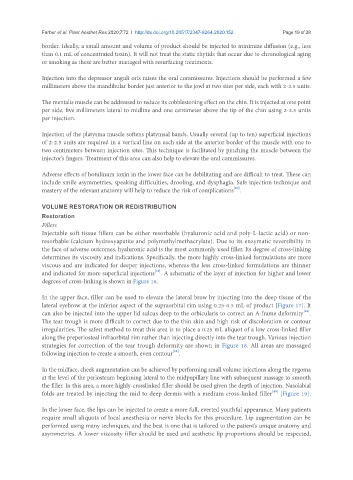Page 869 - Read Online
P. 869
Farber et al. Plast Aesthet Res 2020;7:72 I http://dx.doi.org/10.20517/2347-9264.2020.152 Page 19 of 28
border. Ideally, a small amount and volume of product should be injected to minimize diffusion (e.g., less
than 0.1 mL of concentrated toxin). It will not treat the static rhytids that occur due to chronological aging
or smoking as these are better managed with resurfacing treatments.
Injection into the depressor anguli oris raises the oral commissures. Injections should be performed a few
millimeters above the mandibular border just anterior to the jowl at two sites per side, each with 2-2.5 units.
The mentalis muscle can be addressed to reduce its cobblestoning effect on the chin. It is injected at one point
per side, five millimeters lateral to midline and one centimeter above the tip of the chin using 2-2.5 units
per injection.
Injection of the platysma muscle softens platymsal bands. Usually several (up to ten) superficial injections
of 2-2.5 units are required in a vertical line on each side at the anterior border of the muscle with one to
two centimeters between injection sites. This technique is facilitated by pinching the muscle between the
injector’s fingers. Treatment of this area can also help to elevate the oral commissures.
Adverse effects of botulinum toxin in the lower face can be debilitating and are difficult to treat. These can
include smile asymmetries, speaking difficulties, drooling, and dysphagia. Safe injection technique and
[47]
mastery of the relevant anatomy will help to reduce the risk of complications .
VOLUME RESTORATION OR REDISTRIBUTION
Restoration
Fillers
Injectable soft tissue fillers can be either resorbable (hyaluronic acid and poly-L-lactic acid) or non-
resorbable (calcium hydroxyapatite and polymethylmethacrylate). Due to its enzymatic reversibility in
the face of adverse outcomes, hyaluronic acid is the most commonly used filler. Its degree of cross-linking
determines its viscosity and indications. Specifically, the more highly cross-linked formulations are more
viscous and are indicated for deeper injections, whereas the less cross-linked formulations are thinner
[48]
and indicated for more superficial injections . A schematic of the layer of injection for higher and lower
degrees of cross-linking is shown in Figure 16.
In the upper face, filler can be used to elevate the lateral brow by injecting into the deep tissue of the
lateral eyebrow at the inferior aspect of the supraorbital rim using 0.25-0.5 mL of product [Figure 17]. It
[49]
can also be injected into the upper lid sulcus deep to the orbicularis to correct an A-frame deformity .
The tear trough is more difficult to correct due to the thin skin and high risk of discoloration or contour
irregularities. The safest method to treat this area is to place a 0.25 mL aliquot of a low cross-linked filler
along the preperiosteal infraorbital rim rather than injecting directly into the tear trough. Various injection
strategies for correction of the tear trough deformity are shown in Figure 18. All areas are massaged
[48]
following injection to create a smooth, even contour .
In the midface, cheek augmentation can be achieved by performing small volume injections along the zygoma
at the level of the periosteum beginning lateral to the midpupillary line with subsequent massage to smooth
the filler. In this area, a more highly-crosslinked filler should be used given the depth of injection. Nasolabial
[49]
folds are treated by injecting the mid to deep dermis with a medium cross-linked filler [Figure 19].
In the lower face, the lips can be injected to create a more full, everted youthful appearance. Many patients
require small aliquots of local anesthesia or nerve blocks for this procedure. Lip augmentation can be
performed using many techniques, and the best is one that is tailored to the patient’s unique anatomy and
asymmetries. A lower viscosity filler should be used and aesthetic lip proportions should be respected,

